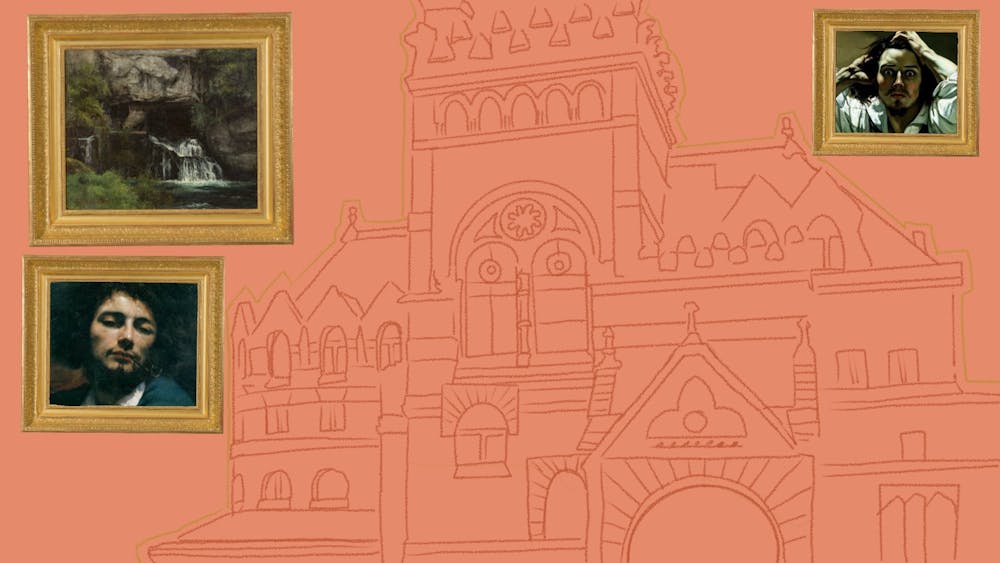In the summer of 2016, construction workers stumbled upon a mystery while performing centennial renovations on the historic Thomas Evans building in Penn Dental Medicine. “My phone rang one day that summer, and Elizabeth Ketterlinus, Senior Associate Dean, announced that construction workers had located two boxes in the [Penn Dental Medicine] basement that might be of interest. An hour later, I was perusing their contents,” says Lynn Marsden–Atlass, director of the Arthur Ross Gallery, remembering the start of a nearly decades–long artistic mystery.
Alongside the old photographs was an unframed canvas; its subject was entirely obscured by darkened varnish that had accumulated after years of neglect. Only three letters, hastily scrawled in red paint, could be discerned: G. Co. “Having previously taught 19th–century French art in the museums in Paris, I suddenly realized I had seen this signature before,” says Marsden–Atlass. She suspected that this unassuming canvas could actually be a lost painting by the famed realist painter Gustave Courbet.
The painting was sent to conservator Barbara Ventresco a few weeks after its discovery, who restored the work to unveil a waterfall and grotto landscape. The three letters were indeed revealed to spell out a full signature: G. Courbet. In the fall of 2016, André Dombrowski, associate professor in the History of Art Department at Penn, and the late Joseph Rishel, a curator at the Rodin Museum at the Philadelphia Museum of Art, examined the art and recommended contacting the Institut Gustave Courbet in Ornans, France, to submit a request to authenticate the canvas.
In 2018, fine art analysts sampled and analyzed the pigments and canvas, finding that the palette of the work was consistent with that used by Courbet during his career. Finally, after years of rumination, on May 17, an email from Sébastien Fernier, secretary of the Institut Gustave Courbet confirmed the findings: “It’s a Courbet, congratulations!”
Entitled La Source du Lison, the lost river landscape is one of many that Gustave Courbet painted of his native Franche–Comté. Though far tamer than the provocative and political paintings Courbet is notorious for, such as "The Origin of the World," La Source du Lison can likewise be read as a socio–political commentary on the environment and gender. Dombrowski noted that Courbet was part of groups demanding the preservation and more careful geological study of sites like the Lison source, then under much threat from growing industrialization. Courbet presents a close–up of the waterfall as untouched and pristine in order to invoke an image of a pure Earth and intentionally excludes the mills and factories directly on the Lison.
Alternatively, based on Courbet’s history of sexualizing nature and water, we could contextualize "The Source of the Lison" as “a figment of the 19th century male artistic imagination, a sexual fantasy that maps the female body onto a remote landscape,” says Dombrowski.
Still, how did a rare Courbet find itself in a box at Penn's Dental School? The answer lies in the story of a famed dentist—and unlikely collector.
Born and raised in Philadelphia, Thomas Evans was renowned across Europe as the premier royal dentist of the late 19th century. Evans amassed wealth and fame amongst royal courts for his usage of nitrous oxide, colloquially known as laughing gas. Awarded the Legion of Honor by Napoléon III, Evans also played important roles in French and American politics. He quickly amassed wealth from his medical practice, as well as favors from his aristocratic clients, permitting his eventual acquisition of La Source du Lison.
Upon his death in 1897, Evans dedicated his estate to establishing the Thomas W. Evans Museum & Dental Institute, which was formally founded at the University of Pennsylvania in 1915 to house dental classes as well as Evans' collections of art. However, in the spring of 1967, the museum was closed and the collection was placed in storage to make way for a dental clinic, landing the Courbet in a back closet at the Dental School—to be found half a century later.
So, next time you find yourself in a back room at Penn, remember to check each and every corner. You might just uncover a long–lost artistic masterpiece.







